Summary
Summary Extra notes for finance with all important formulas
- Course
- Institution
- Book
This document contains all important formulas, theory explained and notes for the finance book. It also has templates that can be used to easily create capital budgeting, graphs,...
[Show more]







